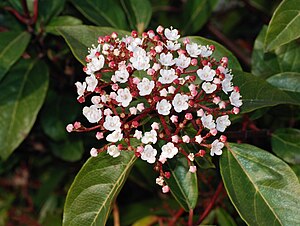Note: This is a project under development. The articles on this wiki are just being initiated and broadly incomplete. You can Help creating new pages.
Difference between revisions of "Viburnum tinus - Laurustinus viburnum"
| Line 7: | Line 7: | ||
==Parts Used== | ==Parts Used== | ||
| − | {{Parts Used| | + | {{Parts Used|Fruits}}, {{Parts Used|Leaves}}. |
==Chemical Composition== | ==Chemical Composition== | ||
| − | + | Methyl (2R-3-α-L-rhamnopyranosyloxy)glycerate, methyl (3R-4-α-L-rhamnopyranosyloxy-3-hydroxy)butanoate, bridelionoside B, (6S,7E,9R)-roseoside, linarionoside A, 3,7,11-trimethyl-1,6-dodecadien-3,10,11-triol, (+)-8-hydroxylinalool, β-sitosterol and daucosterol<ref name="chemical composition"/> | |
==Common names== | ==Common names== | ||
| Line 72: | Line 72: | ||
<references> | <references> | ||
| − | <ref name="chemical composition">[https://www. | + | <ref name="chemical composition">[https://www.tandfonline.com/doi/abs/10.1080/14786419.2018.1428593 "chemical constituents"]</ref> |
| − | <ref name="Leaf">[https | + | <ref name="Leaf">[https://www.gardenershq.com/viburnum-tinus.php "plant description"]</ref> |
<ref name="How to plant/cultivate">[https://www.pfaf.org/user/Plant.aspx?LatinName=Viburnum+tinus "Cultivation details"]</ref> | <ref name="How to plant/cultivate">[https://www.pfaf.org/user/Plant.aspx?LatinName=Viburnum+tinus "Cultivation details"]</ref> | ||
Revision as of 15:47, 14 June 2018
Viburnum tinus is a species of flowering plant in the family Adoxaceae, native to the Mediterranean area of Europe and North Africa. Laurus signifies the leaves' similarities to bay laurel.
Contents
- 1 Uses
- 2 Parts Used
- 3 Chemical Composition
- 4 Common names
- 5 Properties
- 6 Habit
- 7 Identification
- 8 List of Ayurvedic medicine in which the herb is used
- 9 Where to get the saplings
- 10 Mode of Propagation
- 11 How to plant/cultivate
- 12 Commonly seen growing in areas
- 13 Photo Gallery
- 14 References
- 15 External Links
Uses
Wounds, Cuts, Snakebites, Curing liver disorders, Skin eruptions, Blotches, Pimples, Diarrhea, Sore throats
Parts Used
Chemical Composition
Methyl (2R-3-α-L-rhamnopyranosyloxy)glycerate, methyl (3R-4-α-L-rhamnopyranosyloxy-3-hydroxy)butanoate, bridelionoside B, (6S,7E,9R)-roseoside, linarionoside A, 3,7,11-trimethyl-1,6-dodecadien-3,10,11-triol, (+)-8-hydroxylinalool, β-sitosterol and daucosterol[1]
Common names
| Language | Common name |
|---|---|
| Kannada | |
| Hindi | |
| Malayalam | |
| Tamil | |
| Telugu | |
| Marathi | NA |
| Gujarathi | NA |
| Punjabi | NA |
| Kashmiri | NA |
| Sanskrit | |
| English | Agrimony |
Properties
Reference: Dravya - Substance, Rasa - Taste, Guna - Qualities, Veerya - Potency, Vipaka - Post-digesion effect, Karma - Pharmacological activity, Prabhava - Therepeutics.
Dravya
Rasa
Tikta (Bitter), Kashaya (Astringent)
Guna
Laghu (Light), Ruksha (Dry), Tikshna (Sharp)
Veerya
Ushna (Hot)
Vipaka
Katu (Pungent)
Karma
Kapha, Vata
Prabhava
Habit
Identification
Leaf
| Kind | Shape | Feature |
|---|---|---|
| Simple | ovate–elliptic | Shiny dark green leaves are evergreen and similar in shape to those of bay laurel |
Flower
| Type | Size | Color and composition | Stamen | More information |
|---|---|---|---|---|
| Unisexual | 2-4cm long | pinkish-white | 5-20 | Flowers Season is June - August |
Fruit
| Type | Size | Mass | Appearance | Seeds | More information |
|---|---|---|---|---|---|
| 7–10 mm | Laurustinus fruit by Wendy Cutler | With hooked hairs | - | {{{6}}} |
Other features
List of Ayurvedic medicine in which the herb is used
- Vishatinduka Taila as root juice extract
Where to get the saplings
Mode of Propagation
How to plant/cultivate
Landscape Uses:Border, Massing, Screen, Specimen. An easily grown plant, succeeding in both acid and alkaline soils but it is ill-adapted for poor soils and dry situations[3]
Commonly seen growing in areas
Luxuriant type of macchia vegetation, Undergrowth in woods, Near the sea region.
Photo Gallery
Viburnum tinus fruits and blossoms, in Sierra Madrona
Template:VI-tinyViburnum tinus
References
External Links
- Ayurvedic Herbs known to be helpful to treat Wounds
- Ayurvedic Herbs known to be helpful to treat Cuts
- Ayurvedic Herbs known to be helpful to treat Snakebites
- Ayurvedic Herbs known to be helpful to treat Curing liver disorders
- Ayurvedic Herbs known to be helpful to treat Skin eruptions
- Ayurvedic Herbs known to be helpful to treat Blotches
- Ayurvedic Herbs known to be helpful to treat Pimples
- Ayurvedic Herbs known to be helpful to treat Diarrhea
- Ayurvedic Herbs known to be helpful to treat Sore throats
- Herbs with Fruits used in medicine
- Herbs with Leaves used in medicine
- Herbs with common name in English
- Habit - Evergreen Shrub
- Index of Plants which can be propagated by Seeds
- Index of Plants which can be propagated by Cuttings
- Herbs that are commonly seen in the region of Luxuriant type of macchia vegetation
- Herbs that are commonly seen in the region of Undergrowth in woods
- Herbs that are commonly seen in the region of Near the sea region
- Herbs






